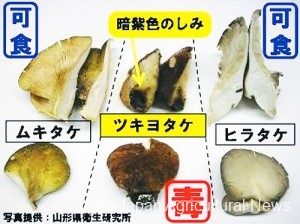TOKYO, Sep. 18 – Is that mushroom safe to eat? Every autumn, there is no end to people suffering from food poisoning from eating wild mushrooms. Mushroom poisoning typically peaks from September to November. Seeing one fatal case last year, the Ministry of Health, Labor and Welfare (MHLW) is calling attention to it.
According to the MHLW, Japan counted 595 mushroom-borne poisoning patients over the ten years until 2024. Among them, 566 cases were reported in September, October, and November, accounting for more than 90% of all cases.
Over the past decade, up to 2024, the most common cause of mushroom poisoning in Japan was Omphalotus japonicus, commonly known as Tsukiyotake in Japan, which resulted in 305 illnesses. Tsukiyotake is often mistaken for oyster mushrooms (Pleurotus ostreatus), Mukitake (Sarcomixa serotina), and Shiitake mushrooms (Lentinula edodes). The mushroom which caused the most significant number of deaths (2) was Dokutsurutake (Amanita virosa), which is often misidentified as Shiromatsutake-modoki (Tricholoma radicans), Haratake (Agaricus campestris), and Tsukuritake (Agaricus bisporus).
In 2024, Dokutsurutake caused 48 illnesses nationwide and one death. According to the Nagano Public Health Center, in July of last year, a male resident in his 20s ate poisonous mushrooms, probably Dokutsurudake or Kotengutake-modeki, which he had found growing naturally on the roadside in Ueda City, Nagano Prefecture. Later, he suffered vomiting, diarrhea, and abdominal pain and went to a hospital, but died.
Caution is also required while dining out. In October last year, a mass food poisoning case occurred in Anan City, Tokushima Prefecture, at a local restaurant that mistakenly served Tsukiyotake brought in by a visitor to the restaurant. Eight people, including the restaurant owner, ate it as grilled mushrooms, and later had food poisoning.
There are mushrooms with no names that are difficult to identify, even for experts. The ministry is therefore advising people not to 1) pick, 2) eat, 3) sell, or 4) give mushrooms if they are unsure about their safety.


